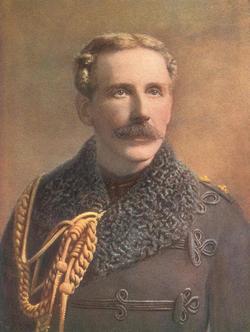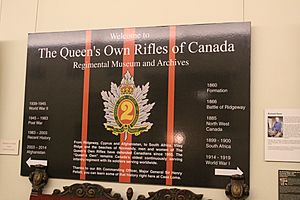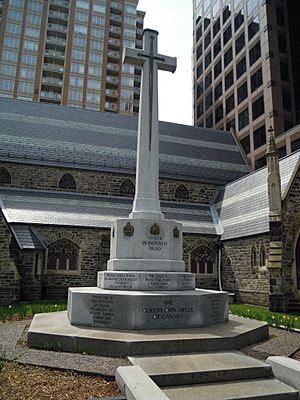The Queen's Own Rifles of Canada facts for kids
Quick facts for kids The Queen's Own Rifles of Canada |
|
|---|---|

Regimental cap badge
|
|
| Active | April 26, 1860 – present |
| Country | Province of Canada (1860–1867) Canada (1867–present) |
| Branch | Canadian Army |
| Type | Rifles |
| Role | Light infantry |
| Size | One battalion |
| Part of | 32 Canadian Brigade Group |
| Garrison/HQ | Moss Park Armoury, Toronto (HQ)/Scarborough |
| Motto(s) | Latin: In pace paratus, lit. 'In peace prepared' |
| Colors | None (rifle regiments have no colours) |
| March | Quick: "The Buffs" Double Past: "Money Musk" |
| Anniversaries | 150th Anniversary on April 26, 2010 |
| Commanders | |
| Current commander |
Lieutenant-Colonel Scott Moody, CD |
| Colonel-in-Chief | Camilla, Duchess of Cornwall |
| Insignia | |
| NATO Map Symbol |  |
| Abbreviation | QOR of C |
The Queen's Own Rifles of Canada is a special army group in Canada. It's part of the Canadian Armed Forces and is based in Toronto. This group is unique because it's the only reserve unit in Canada that has a special role for parachuting.
The Queen's Own Rifles of Canada trains at Moss Park Armoury in downtown Toronto. Their motto is in pace paratus, which means "in peace prepared."
Contents
- What is the Queen's Own Rifles of Canada?
- What is the Role of the Queen's Own Rifles?
- A Look Back: History of the Regiment
- Battle Honours: A Mark of Bravery
- Important Battles and Engagements
- Victoria Cross Heroes
- Special Leaders: Colonels-in-Chief
- Famous People from the Regiment
- The Queen's Own Rifles of Canada Regimental Museum and Archives
- Regimental Church
- Memorials: Remembering the Fallen
- Alliances: Friends in Arms
- Images for kids
What is the Queen's Own Rifles of Canada?
The Queen's Own Rifles of Canada is a "Primary Reserve" regiment. This means its members are part-time soldiers who train regularly. They can be called upon to serve Canada when needed. The group includes a reserve battalion, a Regimental Association, and a Regimental Band and Bugles. People often call them "The QOR of C" or just "QOR."
How is the Regiment Organized?
The reserve battalion is made up of different companies, each with a special job:
- Battalion Headquarters & Signals Company (manages the group and communications)
- 60th Company and Buffs Company (regular infantry companies)
- Parachute Company (soldiers who jump from planes!)
- Victoria Company (helps with combat support and services)
- Normandy Company (trains new soldiers)
- Regimental Band & Bugles (provides music for events)
What is the Role of the Queen's Own Rifles?
The Queen's Own Rifles of Canada is the only reserve unit in Canada that focuses on parachuting. This means their soldiers are trained to jump out of airplanes.
Special Skills and Training
Members of the QOR learn many special skills:
- They have qualified Parachute Instructors who teach others how to jump safely.
- They have Drop Zone/Landing Zone Controllers who manage where parachutes land.
- They have Jumpmasters who lead parachute jumps.
- Soldiers also take courses in helicopter operations and how to deliver supplies from the air.
- Some members become instructors for advanced mountain operations.
- Qualified soldiers who jump are proud to wear a special maroon beret.
- Trained soldiers in this regiment are called Riflemen.
The Queen's Own Rifles also helps the Canadian Army Advanced Warfare Centre. They provide parachute instructors and support for parachute courses. Sometimes, a group of their paratroopers joins the 3 RCR parachute company for missions.
The battalion often practices parachute jumps during training exercises throughout the year.
SkyHawks Parachute Team
Several members of the Queen's Own Rifles of Canada have joined the Canadian Forces SkyHawks Parachute Demonstration Team. This is an elite team that performs amazing parachute jumps for the public.
A Look Back: History of the Regiment
The Queen's Own Rifles of Canada has a long and proud history. It started on April 26, 1860, even before Canada became a country! It was first called the 2nd Battalion, Volunteer Militia Rifles of Canada.
Early Years and First Battles
In 1862, students from the University of Toronto formed a rifle company that became part of the Queen's Own Rifles.
The regiment was renamed the Second Battalion Volunteer Militia Rifles of Canada or Queen's Own Rifles of Toronto in 1863.
The Fenian Raids
The Queen's Own Rifles first saw real combat during the Fenian Raids in 1866. They fought on the Niagara frontier and sadly lost nine soldiers in the Battle of Ridgeway. They were up against experienced fighters from the American Civil War.
The regiment was renamed 2nd Battalion, Queen's Own Rifles of Canada in 1882.
North West Rebellion
In 1885, parts of the regiment helped in the North West Rebellion. They served with the Battleford Column.
South African War
The regiment was named the 2nd Regiment Queen's Own Rifles of Canada in 1900. During the Second Boer War (also called the South African War), soldiers from the regiment fought in a foreign country for the first time. They earned a special honor called a battle honour for their service.
The Great War (World War I)
When the First World War began in 1914, the Queen's Own Rifles helped protect local areas.
The regiment formed the 3rd Canadian Battalion (Toronto Regiment), CEF. This battalion went to Britain and then to France in 1915. They fought bravely until the war ended. The Queen's Own Rifles also helped recruit soldiers for other Canadian battalions during the war.
Between the Wars
On May 1, 1920, the regiment was officially named "The Queen's Own Rifles of Canada."
The Second World War
The regiment became active for service on May 24, 1940. It was called the 1st Battalion, The Queen's Own Rifles of Canada, CASF. They served in Newfoundland (which was a separate country back then) to protect airfields. In 1941, they went to Britain for more training.
A 3rd Battalion was also formed in 1942 for home defense in Canada.
D-Day and Beyond
For the Invasion of Normandy on June 6, 1944, the Queen's Own Rifles landed on "Nan" sector of Juno Beach in France. With the help of tanks, they captured the town of Bernières-sur-Mer. They were the only regiment to reach their goal that day, but they also had the most casualties, with 143 soldiers killed, wounded, or captured.
They also fought in the battle for Caen, including Operation Windsor to capture the airfield at Carpiquet.
During the war, 463 riflemen from the QOR were killed, and almost 900 were wounded. They fought through Normandy, Northern France, Belgium, and the Netherlands, helping to free important port cities. Another 60 members died while serving with other units.
After the war, a 4th Battalion was formed in 1945 to serve in Germany as an occupation force.
In 1953, the regiment became part of the Regular Force, meaning its soldiers were full-time. It had two Regular Force battalions and a Reserve battalion in Toronto.
Korea
The 2nd Battalion of the Queen's Own Rifles served in Korea after the war ended, from 1954 to 1955. Sadly, some members of the 2nd Battalion died while serving in Korea.
Cold War and Recent Deployments
During the Cold War, the Regular Force battalions served with NATO in Germany and with the United Nations in Cyprus.
From 1983 to 1995, the regiment also provided an airborne company to the Canadian Airborne Regiment.
Members of the Queen's Own Rifles of Canada have served in many places around the world more recently. These include Namibia, Cambodia, Cyprus, Somalia, Sierra Leone, Bosnia, Kosovo, Afghanistan, Darfur, and Sudan.
In 2005, the unit helped buy the Victoria Cross of Corporal Frederick George Topham and donated it to the Canadian War Museum.
In 2006, the QOR opened Dalton Armoury in Scarborough. The "Buffs Company" trains there. The QOR has a special connection with "The Buffs (East Kent) Regiment" from the British Army, sharing a regimental march.
Battle Honours: A Mark of Bravery
The Queen's Own Rifles of Canada has earned 47 battle honours throughout its history. These are special awards that show where the regiment fought bravely. They are displayed on the Regimental drums, as Rifle Regiments do not carry "colours" (flags).
Early Years Honours
First World War Honours
- Ypres, 1915
- St. Julien
- Festubert, 1915
- Mount Sorrel
- Somme, 1916
- Flers-Courcelette
- Arras, 1917
- Vimy, 1917
- Hill 70
- Passchendaele
- Amiens
- Arras, 1918
- Canal du Nord
- Pursuit to Mons
- France and Flanders, 1915–18
Second World War Honours
- Normandy Landing
- Le Mesnil-Patry
- Caen
- Carpiquet
- Bourguébus Ridge
- Falaise
- Boulogne, 1944
- Calais, 1944
- The Scheldt
- The Rhineland
- The Hochwald
- The Rhine
- North-West Europe, 1944–45
Recent Honours
- Afghanistan
Important Battles and Engagements
The Queen's Own Rifles has been part of many important battles throughout history:
- Battle of Ridgeway, Fenian Raids, 1866
- Battle of Cut Knife, North-West Rebellion, 1885
- First World War battles like St Julien, Hill 70, Passchendaele, Mount Sorrel, Amiens, Somme (1916), Flers-Courcelette, Canal du Nord, Pursuit to Mons, and Vimy (1917).
- Second World War battles like Normandy Landing, Le Mesnil-Patry, The Scheldt, Caen, The Rhineland, Bourguebus Ridge, The Hochwald, Falaise, The Rhine, and Boulogne (1944).
Victoria Cross Heroes
Seven members of the Regiment have received the Victoria Cross. This is Canada's highest award for bravery in the military.
- Capt Thain Wendell MacDowell, VC, DSO (April 9, 1917)
- Cpl Colin Fraser Barron, VC (November 6, 1917)
- 2Lt Edmund De Wind, VC (Killed in action March 21, 1918)
- Lt Charles Smith Rutherford, VC, MC, MM (August 26, 1918)
- Lt Wallace Lloyd Algie, VC (Killed in action October 11, 1918)
- Lt George Fraser Kerr, VC, MC & Bar, MM (September 27, 1918)
- Sgt Aubrey Cosens, VC (Killed in action February 25/26, 1945)
Special Leaders: Colonels-in-Chief
The regiment has a special ceremonial leader called the Colonel-in-Chief.
- Queen Mary (1928–1953)
- Princess Alexandra, The Honourable Lady Ogilvy (1960–2010)
- The Duchess of Cornwall (2010–present)
Famous People from the Regiment
Many notable Canadians have been part of The Queen's Own Rifles of Canada:
- Vincent Massey became the first Canadian Governor General of Canada in 1952.
- Donald Ethell was the Lieutenant-Governor of Alberta.
- Sir John Morison Gibson was a Lieutenant Governor of Ontario and fought in the Fenian Raids.
- Sir Hugh John Macdonald was the son of Canada's first Prime Minister, John A. Macdonald. He also served as Premier of Manitoba.
- Lieutenant-Colonel Barney Danson fought in Normandy and later became the Minister of National Defence.
- General Sir William Dillon Otter was the first Canadian-born head of the Canadian Army.
- Lieutenant-General Charles H. Belzile was also a former head of the Canadian Army.
- Major-General Lewis MacKenzie commanded a UN force in Yugoslavia.
- Major-General Malcolm Mercer led the 3rd Canadian Division in the First World War and was the most senior Canadian officer to die in combat.
- Major-General Sir Henry Pellatt was a financier who built Casa Loma in Toronto.
- Brigadier General John "Jock" Spragge was the commanding officer of the Queen's Own Rifles on D-Day.
- Lieutenant-Colonel John McCrae wrote the famous poem In Flanders Fields.
- Lieutenant-Colonel Arthur Godfrey Peuchen was a businessman and a survivor of the RMS Titanic.
- Major John Hasek was the first commander of the SkyHawks Parachute Team.
- Major Ben Dunkelman fought bravely in the Second World War.
- Major Edward Arunah Dunlop, Jr. was blinded in the Second World War while trying to save a soldier.
- Alexander Muir wrote the song "The Maple Leaf Forever" and fought at the Battle of Ridgeway.
- Lance corporal Albert Tilson was a hockey player.
The Queen's Own Rifles of Canada Regimental Museum and Archives
The museum for the Queen's Own Rifles of Canada is located on the third floor of the famous Casa Loma castle in Toronto. Sir Henry Pellatt, who built Casa Loma, was a big supporter of the regiment.
In 2008, some old, non-working firearms were stolen from the museum but were later found and returned.
Regimental Church
St. Paul's, Bloor Street, an Anglican Church in Toronto, has been the special church for the QOR since 1910.
Outside the church, there is a Cross of Sacrifice. It honors the members of the QOR who died in combat, built after the First World War. Inside the church, there are Books of Remembrance that list the names of the fallen QOR soldiers. These books are shown every year on Remembrance Day Sunday.
Memorials: Remembering the Fallen
There are many memorials to remember the brave soldiers of the Queen's Own Rifles.
- A regimental badge is carved on a pew at the Royal Memorial Chapel in England.
- The oldest memorial is the Ridgeway tablet at the Memorial United Church in Ridgeway, Ontario. There are also other memorials for Ridgeway in Toronto and at the battle site.
- A monument at the University of Toronto honors those who died defending the frontier in 1866.
- The North-West Rebellion of 1885 is remembered by a monument in Queen's Park, Toronto, and a tablet inside Moss Park Armoury.
- The South African War memorial is on University Avenue in Toronto.
- The First World War is remembered by the Cross of Sacrifice and the Book of Remembrance at St Paul's Anglican Church.
- A plaque in Bernières-sur-Mer, France, marks the D-Day landing site for the Second World War fallen.
- A tablet in Mooshof, Germany, marks where Sergeant Aubrey Cosens, VC, earned his medal.
- Other memorials exist in France and the Netherlands, honoring the regiment's service.
Alliances: Friends in Arms
The Queen's Own Rifles of Canada has special alliances with other military regiments, mostly from the United Kingdom. This means they share traditions and support each other.
Current Alliances
- United Kingdom – The Rifles (since 2007)
- United Kingdom – The Royal Gurkha Rifles (since 1994)
- United Kingdom – The Princess of Wales's Royal Regiment (Queen's and Royal Hampshires) (since 1992)
Past Alliances
The regiment has had alliances with several other British regiments over the years, including:
- Brigade of Gurkhas
- The Royal Green Jackets
- The Queen's Regiment
- The Queen's Own Buffs, The Royal Kent Regiment
- The King's Royal Rifle Corps
- The Buffs (Royal East Kent Regiment)
- The Buffs (East Kent Regiment)
Images for kids







